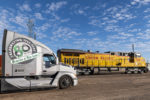Archives
Business, Feature, Freight News, Rail, Sea
Long Beach, UP, BNSF Gird for ‘Year of Rail’
[ April 12, 2024 // Gary G Burrows ]Port of Long Beach CEO Mario Cordero declared 2024 the “year of rail,” supported through investments by Class I railroads Union Pacific and BNSF, during his recent state-of-the-port address in January.
Four port projects are in design or under construction at the Southern California container port, including major segments of the centerpiece of the port’s new rail infrastructure, the Pier B On-Dock Rail Support Facility. The US$1.56 billion program will serve as the port’s hub for staging and assembling trains to further improve the velocity of imports and exports to and from nationwide markets.
As the port breaks ground on the first phase of the Pier B facility, UP and BNSF have moved forward with their own projects to boost freight rail services in the U.S. Southeast and intercontinental network: UP’s Phoenix Intermodal Center, which opened Feb. 1, and BNSF’s Barstow International Gateway, or BIG.
Cordero said the railroads’ efforts will strengthen West Coast competitiveness and advance the port’s efficiency goals that include moving 35 percent of cargo by on-dock rail, and reduce carbon emissions by shifting more containers to rail.
The port’s US$1.56 in planned investment follows on from more than US$500 million in investments over the past two decades on 10 major projects to modernize its rail network for cargo in and out of the port.
Phoenix Intermodal Center
The Port of Long Beach said the Union Pacific’s recently opened Phoenix Intermodal Center is the first-of-its-kind rail service between the San Pedro ports and Phoenix, the 10th-largest U.S. metropolitan area with a population of more than 5 million.
The intermodal center, which opened merely 45 days after the railroad announced the project, is 350 miles east of the California ports, a distance once considered too costly for rail versus trucking. Work included repurposing and upgrading an underutilized UP rail yard and adding a ramp and lift equipment for transferring international containers between well cars and chassis. UP said the project’s prompt turnaround positions itself ahead of May 1, the date by which annual global shipping service contracts and rate agreements are typically finalized.
Beyond price, speed and reliability, UP said its new rail service connecting the San Pedro Bay ports directly to Phoenix will reduce traffic congestion on Southern California’s roadways and eliminate more than 25,000 tonnes of greenhouse gases annually. Phoenix-bound cargo will come directly from on-dock rail yards, as well as the near-dock Intermodal Container Transfer Facility operated by Union Pacific.
UP has partnered with Duncan and Son Lines, a Phoenix-based family-owned logistics firm, to provide drayage services between the new facility and nearby distribution centers.
While the cost of moving containers to Phoenix via truck has been less expensive, “with rapidly increasing costs for trucks, drivers, fuel, etc., as well as CARB requirements, the cost of trucking has become very similar to rail,” said Keith Jones, vice president of xales for Duncan and Son Lines’ parent company DSL Logistics Inc.
Founded in 1934, Duncan and Son Lines and its fleet of 500 trucks and 3,000 intermodal chassis have served the San Pedro Bay ports for more than 30 years, and is compliant with the California Air Resources Board, including onboarding of 70 zero-emissions trucks and electric charging stations in Southern California.
Barstow International Gateway
BNSF’s 4,500-acre master-planned rail facility is proposed for the desert city of Barstow, nearly 135 miles northeast of the San Pedro Bay ports complex. The US$1.5 billion project would process both eastbound containers destined for inland U.S. markets and westbound containers destined for markets overseas. The full-service rail yard “evolve beyond the traditional model of an intermodal facility, and will include multiple onsite warehouses for transloading to streamline moving cargo between international and domestic containers, said Katie Farmer, CEO of BNSF.
Key sustainability elements include a solar farm that would generate clean energy to supplement its onsite electricity needs, including powering electric hostlers for moving containers from the facility’s intermodal ramp to its transloading warehouses.
BIG’s size also positions it to significantly reduce truck trips and congestion on Southern California roadways. In addition to enhancing cargo fluidity, the ports estimate that each train that hauls containers from on-dock rail yards to their destination can replace up to 750 truck trips.
Subject to the California Environmental Quality Act, which requires a comprehensive environmental impact study, BIG is at the front end of the process, including a draft Environmental Impact Report, or EIR in mid-February.
Once the EIR is approved, construction immediately with BIG expected to open in 2028.

Union Pacific has partnered with Duncan and Son Lines to provide drayage services between the Phoenix Intermodal Center and nearby distribution centers. PHOTO: Union Pacific

Tags: BNSF, Port of Long Beach, Union Pacific










